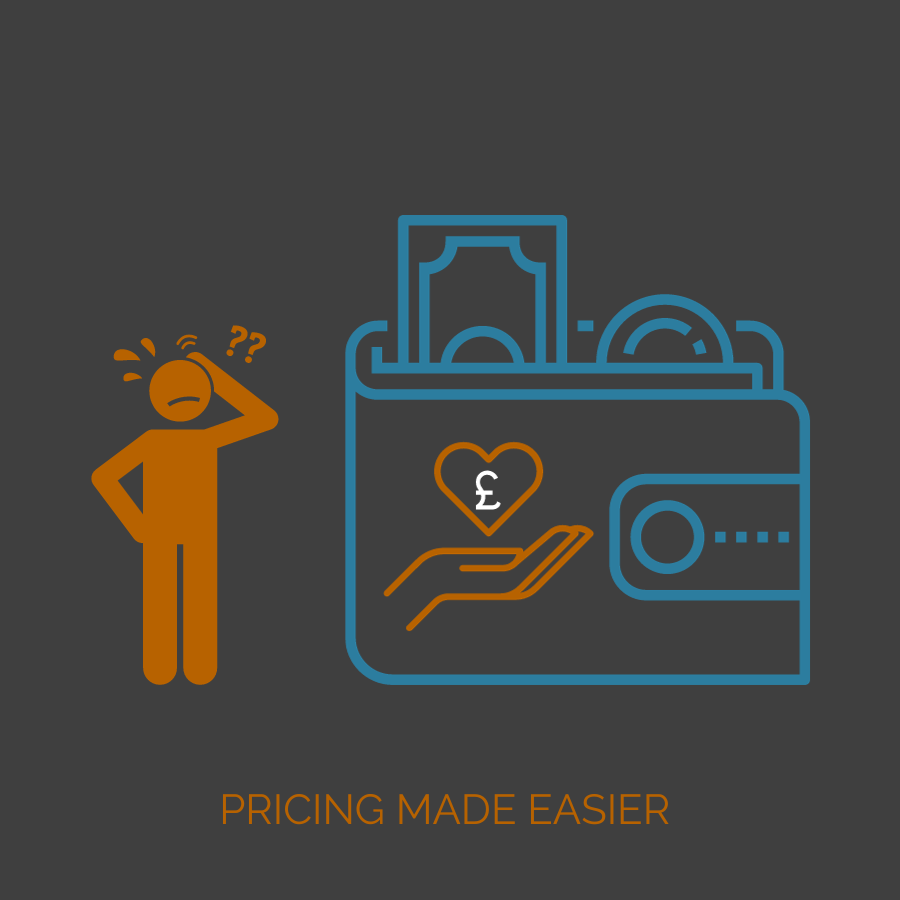There is no one-size-fits-all answer to the question of how to set pricing.
But the starting point must be self belief, supported by confidence, trust, and the viability of what we have created, to price.
And it’s important to understand the type of service/product you offer, your industry, your target market, and your competitors.
So in advance of your pricing make sure you have a SWOT analysed Business Model. If not, here are link to articles on both recommended reads before you dive into pricing.
However, there are a few general principles that you can follow to help you determine a fair and profitable price for your services:
Calculate your costs. This includes both your direct costs (such as the cost of materials and labour) and your indirect costs (such as overheads and marketing). Once you have a good understanding of your costs, you can start to think about how much you need to charge in order to cover your costs and make a profit.
Research your market. Take a look at what your competitors are charging for similar services. You don’t want to price yourself too high or too low, so it’s important to be competitive. However, you should also keep in mind that the lowest price isn’t always the best way to attract customers. If you’re offering a high-quality service, you can justify charging a premium price.
Know your customers. What are their needs and budget? How much are they willing to pay for your service? Once you understand your customers, you can better tailor your pricing strategy to their needs.
Consider your time invested. How long did it take you to learn your craft. Do you have to keep up continual learning? How much time does it take you to deliver? If you’re spending a lot of time on each customer/product, you need to make sure that you’re charging enough to compensate for your time.
Come up with a fair profit margin. How much do you want to make on each service/product? It’s important to set a profit margin that is fair to both you and your customers. And you have your health to factor in, if you work so hard you don’t take a break or holiday, your service will suffer and so will you.
Your reputation. If you’ve already been selling, how has this been received? How are you perceived by experience, reputation, and quality of your work? What, if anything, do you want to change? And will this impact your visual and written messaging?
Once you’ve considered all of these factors, you can start to develop a pricing strategy.
Pricing Strategy
There are a number of different strategies that you can use, such as:
Hourly Pricing: Charge a fixed hourly rate for your services. This is a simple and straightforward pricing strategy, but it can be difficult to estimate how long each project will take, which can lead to undercharging or overcharging customers.
Project-based Pricing: Charge a fixed price for each project. This is a good option for projects with a well-defined scope of work. However, it can be difficult to price projects accurately, especially if you’re new to the business.
Value-based Pricing: Charge a price based on the value that your service provides to the customer. This is a more complex pricing strategy, but it can be very effective if you can accurately assess the value of your service to your customers.
Fixed Cost: cost remains the same despite volume or service i.e.. salaries, rent etc.
Variable Cost: varying according to service/product (such as festivals – more sales = more staff etc.)
What can impact your pricing
Scale: buying in bulk, costs falling as output rises
Scope: advantages may be that the larger you become you may still use the same marketing/sales team size …
What you want to be know for
Cost Driven: saving where possible, a low budget model
Value Driven: creating premium propositions, lavish, luxury, personal (1:1)
Mass Market: providing essential items at a competitive price
Niche Market: for specialised customers, buying for specific wants and needs
Co-Creation: sharing costs, marketing, promotions – and where customers are involved in your evolution
Be flexible
No matter what pricing strategy you choose, it’s important to be flexible and willing to adjust your prices as needed. For example, you may wish to offer discounts to new customers or to customers who sign up for multiple services. You may also need to raise your prices if your costs increase.
The most important thing is to find a pricing strategy that works for you and your business.
Is it possible to experiment with different strategies?
Would your customers understand if you work by referral.
Could you create different services/products, depending on how much time each would take?

